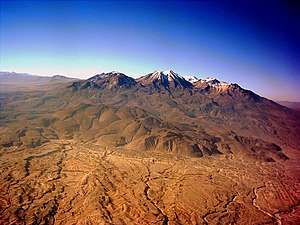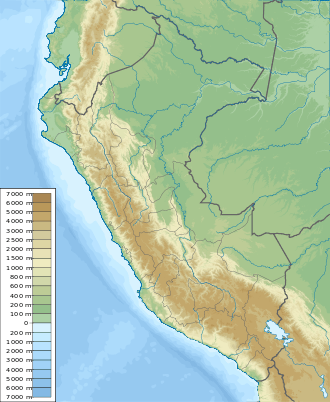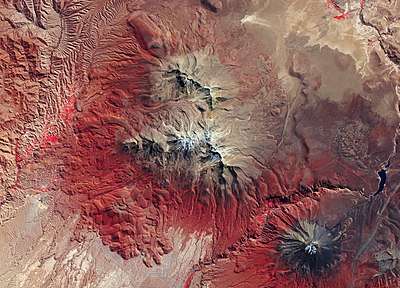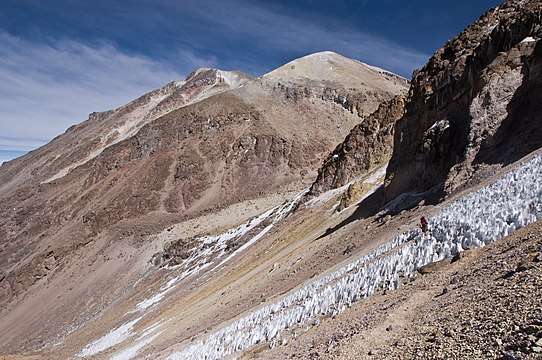Chachani
Chachani is a volcanic complex in southern Peru, 22 kilometres (14 mi) northwest of the city of Arequipa. Part of the Central Volcanic Zone of the Andes, it is 6,057 metres (19,872 ft) above sea level. It consists of several lava domes and individual volcanoes such as Nocarane, along with lava shields such as the Airport Domes. Underneath Chachani lies a caldera.
| Chachani | |
|---|---|
 Chachani viewed from the south | |
| Highest point | |
| Elevation | 6,057 m (19,872 ft) [1] |
| Prominence | 1,963 m (6,440 ft) |
| Coordinates | 16°11′S 71°31′W [1] |
| Geography | |
 Chachani | |
| Geology | |
| Mountain type | Volcanic complex |
| Last eruption | Unknown |
During the Pliocene and early Pleistocene, the volcanic complex produced large ignimbrites such as the La Joya, Arequipa Airport and Yura Tuff ignimbrites; afterwards the volcanic complex proper grew in the caldera until about 56,500 years ago. There have not been any eruptions during historical time, but the volcano is considered to be only dormant and due to its closeness to the city of Arequipa is considered high risk.
Name
The name means "brave" in Aymara[2] or "mountain of man"/"mountain of male";[3] alternative spellings "Cacheni" and "Charchani" are also known.[4]
Geography and geomorphology
The volcano lies in the Andes of southern Peru,[5] 22 kilometres (14 mi)[1] northwest of Arequipa and north of the Arequipa Airport;[6] the city of Arequipa is situated on the foot of Chachani and El Misti volcanoes.[7] The road from Arequipa to Chivay runs along the southeastern foot of Chachani,[8] and a dirt road reaches to an elevation of 5,000 metres (16,000 ft). It is considered to be one of the most easily climbed mountains between 6,000 - 7,000 m high, although acclimatization and good physical health are required to ascend it.[2]
Volcanoes in the southern part of Peru include from north to south Auquihuato, Firura, Coropuna, Andagua volcanic field, Sabancaya, Ampato, Chachani, El Misti, Pichu Pichu, Ubinas which has erupted intermittently since 1954, Huaynaputina where a large eruption occurred in 1600, Ticsani, Tutupaca, Yucamane and Casiri. Some of these volcanoes are among the highest in the world,[9][10] and on average, there is one eruption of a Peruvian volcano every 13 years.[11] The Peruvian volcanoes are part of the Central Volcanic Zone of the Andes, one of three separate volcanic belts in that mountain chain;[12] the Central Volcanic Zone contains 44 named stratovolcanoes.[13]
Chachani is an about 2 kilometres (1.2 mi) high and 17 kilometres (11 mi) wide[9] complex[lower-alpha 1] of lava domes, stratovolcanoes[5] and volcanic cones;[1] the highest summit is 6,057 metres (19,872 ft) high, making Chachani the 84th highest peak in the Andes.[15] The Chachani complex has an arcuate shape[16] encompassing both the main Chachani volcano and the[17] 5,784 metres (18,976 ft) high[6] Nocarane[18][lower-alpha 2] to the north of Chachani,[6] while the 5,484 metres (17,992 ft) high[2] La Horqueta together with El Rodado to its west and Chachani proper to its east forms an east–west trending ridge.[14] La Horqueta has a young appearance and resembles an ash cone[16] with a crater.[20] Additional peaks are the northerly 5,852 metres (19,199 ft) high los Ángeles and the southeasterly 5,820 metres (19,090 ft) high Trigo.[2]

The Colorado[14] lava domes[21] which are also known as Cerro Penones in turn are located northwest from Nocarane.[17] To the south of Chachani lie the Airport Domes,[14][lower-alpha 3] a 8 kilometres (5.0 mi) wide lava shield[16] with two discernible vents[23] and a pristine appearance.[23] The lava shield consists of overlapping lava flows with a wavy and rugose texture[22] and a steep front which reaches heights of 1.2 kilometres (0.75 mi); evidently these were formed by viscous lava flows.[20] A volcanic caldera associated with widespread ignimbrites in the Arequipa area may be located underneath Chachani;[24] to the north its outline is marked by a 20 kilometres (12 mi) wide amphitheatre while its southern part is continuous with the Arequipa depression and is generally poorly recognizable.[25] The El Misti volcano later arose on the margin of the Chachani caldera, where it intersects the border of the Altiplano.[26]
The volcanic complex is formed mainly by aa and block lava flows that rarely reach lengths of about 10 kilometres (6.2 mi); additionally pyroclastic flows and tephra occur.[21] The volcanic complex covers an area of about 600 square kilometres (230 sq mi) and has a present-day volume of about 154–248 cubic kilometres (37–59 cu mi); this makes Chachani one of the largest volcanoes of the Andes. Glacial erosion and landslides have affected the volcanic complex,[21] forming cirques and U-shaped valleys and removing much of the original shape of the individual volcanoes.[20] Some moraines have been overrun by lava flows.[16]
Chachani drains into the Rio Chili.[27] The Quebrada Canchero, Quebrada Cabrería and Quebrada Traccra drain south to eastward into the river which flows around the southeastern side of Chachani[6] and has cut a canyon between Chachani and El Misti.[28] The Rio Sumbay, one of its tributaries, runs along the eastern side of Chachani.[29] The Rio Yura flows southward along the western side of Chachani, and upon reaching the then westward-flowing Rio Chili becomes the Rio Vitor, which eventually discharges into the Pacific Ocean together with the Rio Siguas.[30]
Glaciation
The volcano underwent five stages of glaciation in the past.[18] During the last glacial maximum extensive glaciers[1] formed well-developed[31] moraines at 3,150–3,600 metres (10,330–11,810 ft) elevation;[18] lateral moraines marking the limit of glaciation are located at 3,440 metres (11,290 ft) elevation on the southern flank.[31] Glaciers may have also formed during the Little Ice Age, where there are moraines at 5,100–5,300 metres (16,700–17,400 ft) elevation;[18] presently however the mountain lacks glaciers[1] and only has a snowfield.[32] In general, glaciers in the tropical Andes have been shrinking after the end of the Little Ice Age, and especially after the 1970s.[5]
Permafrost[18] and rock glaciers however still exist at Chachani, especially close to Nocarane, and reach lengths of 1.8 kilometres (1.1 mi);[6] they are characterized by lobate appearances and their location at the foot of tall cliffs. Some of them (about six in total) are still active and are located above 4,810 metres (15,780 ft) elevation, while the lowest inactive ones end at 4,160 metres (13,650 ft) elevation.[31] Other periglacial phenomena such as needle ice are also encountered on the volcanic complex.[6]
_(5619838885).jpg) Chachani, looking eastward
Chachani, looking eastward Summit area
Summit area.jpg) Chachani viewed from El Misti
Chachani viewed from El Misti
Geology
Subduction of the Nazca Plate beneath the South America Plate[28] occurs at a rate of 4.6 centimetres per year (1.8 in/year);[32] the subduction process is responsible for the volcanism and earthquake activity of the region.[28] In the Andes, volcanism is distributed between three volcanic belts, the Northern Volcanic Zone, the Central Volcanic Zone and the Southern Volcanic Zone which coincide with segments where the downgoing Nazca plate falls steeply into the mantle.[12]
Volcanic activity in the Chachani region appears to have begun during the Cretaceous-Paleocene in the form of the "Toquepala" volcanics.[30] The oldest volcanic rocks of the Western Cordillera are known under the name "Tacaza", and underwent erosion and folding before the next phase which is known as "Sillapaca".[33] Finally, during the Miocene-Quaternary the Sencca Formation and the "Barroso" volcanics developed;[30] Chachani is classified as part of the Barroso volcanics[34][14] although the oldest volcanism might belong to the "Sillapaca" unit.[20]
The terrain of the volcano is formed by volcanic rocks of Eocene to recent age, which overlie a Precambrian basement[28] and include widespread Neogene-Quaternary ignimbrites.[30] Chachani straddles the margin between the higher-elevation Altiplano and the Arequipa basin at lower altitude.[26]
The younger[35] El Misti volcano lies southeast of Chachani, across the Rio Chili.[6] Other volcanoes in the region are Ampato and Jollojello northwest, Baquetane, Hucullani and Nevado Calcha north, Yanarico east and Pichu Pichu southeast from Chachani.[29] Of these, Misti, Pichu Pichu and Chachani are aligned on normal faults that trend northwest–southeast and has been active during the Holocene.[36]
Chachani has erupted andesite and dacite, which define a potassium-rich calc-alkaline suite[21] with unusual adakite characteristics; adakites are magmas that form when the downgoing plate in a subduction setting melts.[37] Phenocrysts include augite, biotite, hornblende and hypersthene;[38] the rhyolites of the Arequipa ignimbrites additionally contain ilmenite, magnetite, plagioclase, quartz and sanidine.[39] The composition of the volcanic rocks has varied over the lifespan of Chachani, sometimes rocks of basaltic andesite composition were erupted as well while the younger volcanoes are usually more homogeneous.[24]
Climate and vegetation
Under the influence of the cold Humboldt Current and the subtropical ridge, the region features an arid climate with less than 100 millimetres (3.9 in) annual precipitation in Arequipa.[40] The zero degree elevation at Chachani lies at about 5,000 metres (16,000 ft). The diurnal temperature range is large and can reach 20 °C (36 °F),[1] while ground temperatures are much more stable and higher than air temperatures.[41]
From 3,500 to 3,900 metres (11,500 to 12,800 ft) elevation cacti, herbs, Peruvian feather grass, yareta but also lichens and mosses grow on the slopes of Chachani and other regional volcanoes.[42] Vegetation is scarce to absent above 4,500 metres (14,800 ft) elevation,[5] and much of its lower slopes were stripped of their vegetation during the colonial era. The dry soils are not suitable for agriculture.[43] Part of the volcano is in the Salinas y Aguada Blanca National Reserve.[44]
Eruption history
The oldest volcanic formations linked to Chachani are the so-called "sillars", which are rhyolitic pyroclastic flows[45]/ignimbrites[46] containing pumice beds.[20] These ignimbrites include the La Joya Ignimbrite of Pliocene age, the Plio-Quaternary Arequipa Airport Ignimbrite and the Quaternary Yura Tuff and Capillune Formation.[47] The 16–24 cubic kilometres (3.8–5.8 cu mi) 4.8 million years old La Joya, the 18–20 cubic kilometres (4.3–4.8 cu mi) 1.65 million years old Arequipa Airport, and less certainly the 1.5 cubic kilometres (0.36 cu mi) early Pleistocene Yura Tuff as well as the Capillune Formation ignimbrites appear to have been erupted by Chachani or (in the case of the Yura Tuff) from a vent north of it.[48] Together with lava flows these form the "Pre-Chachani" units[14] and probably are the largest eruptions experienced by Chachani.[23]
They occur in the wider region of Chachani and crop out in the Arequipa area and in river valleys.[35] Their emplacement took place in the form of fast-moving hot streams of rock.[15] An additional ignimbrite is the 13 million years old[49] Miocene Rio Chili Ignimbrite;[35] the vents of the Miocene units are unknown[39] and the Rio Chili Ignimbrite appears to be related to the Huaylillas Ignimbrite of southern Peru.[49]
Later, during the Quaternary[50] the Chachani volcanic complex grew in the caldera.[22] The older activity formed the older volcanoes Chingana northeast, Estribo east and Nocarane north of Chachani as well as the Colorado lava domes north-northwest from Nocarane and the volcanoes Chachani Base and El Angel; argon-argon dating has yielded ages ranging between 1,000,000 - 500,000 years ago for these volcanoes. Later the volcanoes El Rodado, La Horqueta and Chachani (c. 130,000 - 131,000 years ago) formed as a west–east alignment, along with the Uyupampa lava field (about 230,000 - 280,000 years ago) far west from Chachani, the Airport Domes south (between 290,000 - 400,000 years ago), the Cabrería lava domes south-southeast and the Volcancillo dome northeast from Chachani.[51]
The youngest reported date of 56,500 ± 31,600 years ago has been obtained on the Cabrería lava domes;[14] formerly the Airport Domes/Los Angeles/Pampa de Palacio were considered to be the youngest and of Holocene age.[22] However, a post-glacial lava flow descends the western slope of Chachani between Chachani and Nocarane.[17] No historical eruptions are known at the volcanic complex, and the date of the last activity is likewise unclear.[1]
The existence of solfataras in the summit region[42] and of hot springs[52] at Socosani and Yura has been reported,[23] and frequent seismic activity occurs on Chachani's southwestern flank; this activity may relate to either geothermal or tectonic phenomena.[53] Currently, the volcano is considered to be dormant.[54]
Hazards
.jpg)
The city of Arequipa with about one million inhabitants and infrastructure such as the airport, hydropower plants and reservoirs are within range of Chachani.[55] The western suburbs of Arequipa[16] are 3 kilometres (1.9 mi) below[52] and less than 25 kilometres (16 mi) away from the volcano and in case of renewed eruptions they would be threatened by pyroclastic flows. In addition, melting ice and snow on the summit could generate mudflows,[16] and lava flows and tephra falls are additional hazards.[55] Chachani is considered to be a high-risk volcano[56] and the Geophysical Institute of Peru in 2018 installed a monitoring station on Chachani.[57]
Religious importance and archeology
Chachani is the protector mountain spirit of Cayma[58] The people of Arequipa sometimes refer to Chachani as the "father" of El Misti (Pichu Pichu is the "mother") and ascribed to it the ability to influence the gender of newborn children, making them daughters.[59] The Inca worshipped Chachani and its neighbouring mountains and turned its summit into a mountain sanctuary that was later destroyed by sulfur mining and plundering to the point that no trace of archeological sites can be found, such as e.g. walls.[60] Nevertheless, evidence of Inka human sacrifice known as capacocha was found during archeological expeditions.[61]
Mining
Chachani was reportedly mined for sulfur during the colonial era[62] and for the white "sillar" rocks that were used in construction of the[63] famous buildings of colonial-era Arequipa,[62] which is also known as the "white city".[42]
Notes
References
- Palacios et al. 2009, p. 1.
- "Volcán Chachani" (in Spanish). Ministerio de Comercio Exterior y Turismo. Retrieved 26 May 2019.
- Adelaar, Willem F. H. (2004). The Languages of the Andes. Cambridge University Press. p. 262. ISBN 9781139451123.
- Hatch, Frederick H. (1886-07-01). "Ueber die Gesteine der Vulcangruppe von Arequipa". Mineralogische und petrographische Mitteilungen (in German). 7 (4): 313. ISSN 1438-1168.
- Andrés et al. 2011, p. 151.
- Andrés et al. 2011, p. 152.
- Cuber, Panajew & Gałaś 2015, p. 64.
- Legros 2001, p. 16.
- de Silva & Francis 1990, p. 288.
- Bullard 1962, p. 444.
- Vela et al. 2016, p. 4.
- de Silva & Francis 1990, p. 287.
- Cuber, Panajew & Gałaś 2015, p. 63.
- Aguilar et al. 2015, p. 138.
- Cuber, Panajew & Gałaś 2015, p. 65.
- de Silva & Francis 1990, p. 293.
- de Silva & Francis 1990, pp. 294-295.
- Alcalá, J.; Zamorano, J. J.; Palacios, D. (2012-04-01). "Volcanic and glacial evolution of Chachani-Nocarane complex (Southern Peru) deduced from the geomorphologic map". Egu General Assembly Conference Abstracts. 14: 3677. Bibcode:2012EGUGA..14.3677A.
- Finizola et al. 2004, p. 346.
- Bullard 1962, p. 445.
- Aguilar et al. 2015, p. 139.
- García, Chorowicz & Legros 1997, p. 453.
- "Chachani". volcano.oregonstate.edu. Retrieved 2019-05-26.
- Aguilar et al. 2015, p. 140.
- García, Chorowicz & Legros 1997, p. 450.
- Kosaka Masuno, Macedo Franco & Diaz Urquizo 2000, p. 11.
- Huntington, Ellsworth (1935). "Climatic Pulsations". Geografiska Annaler. 17: 578. doi:10.2307/519887. ISSN 1651-3215. JSTOR 519887.
- Pallares et al. 2015, p. 644.
- García, Chorowicz & Legros 1997, p. 451.
- Lebti et al. 2006, p. 252.
- Payne, D. (1998). "Climatic implications of rock glaciers in the arid Western Cordillera of the Central Andes". Glacial Geology and Geomorphology: 6 – via ResearchGate.
- Pallares et al. 2015, p. 643.
- Bullard 1962, p. 443.
- Kosaka Masuno, Macedo Franco & Diaz Urquizo 2000, p. 14.
- Lebti et al. 2006, p. 254.
- Finizola et al. 2004, p. 348.
- Legros 2001, p. 26.
- Portillo, Felix; Onuma, Naoki; Aramaki, Shigeo (20 October 1984). "Petrography and major element chemistry of the volcanic rocks of the Andes, southern Peru". Geochemical Journal. 18 (5): 226. Bibcode:1984GeocJ..18..217A. doi:10.2343/geochemj.18.217. ISSN 0016-7002.
- Paquereau, P.; Thouret, J.-C.; Wörner, G.; Fornari, M.; Roperch, P. (2003-04-01). "Neogene ignimbrites in the area of Arequipa, southern Peru: correlations, flow directions and sources". Egs - AGU - Eug Joint Assembly: 10465. Bibcode:2003EAEJA....10465P.
- Reygosa, Jesús Alcalá; Palenque, Jose Úbeda; Estremera, David Palacios; Pablo, Nuria de Andrés de (2011). "Medio periglaciar, permafrost y riesgos naturales en un volcán tropical extinto: Nevado Chachani (sur de Perú)". Scripta Nova. Revista Electrónica de Geografía y Ciencias Sociales. 15. ISSN 1138-9788.
- Palacios et al. 2009, p. 2.
- Cuber, Panajew & Gałaś 2015, p. 66.
- Love 2017, p. 26.
- Polk, Mary H.; Young, Kenneth R.; Crews-Meyer, Kelley A. (1 December 2005). "Biodiversity conservation implications of landscape change in an urbanizing desert of Southwestern Peru". Urban Ecosystems. 8 (3): 314. doi:10.1007/s11252-005-4864-x. ISSN 1573-1642.
- García, Chorowicz & Legros 1997, p. 449.
- Lebti et al. 2006, p. 253.
- Lebti et al. 2006, pp. 254-255.
- Lebti et al. 2006, p. 273.
- Lebti et al. 2006, p. 257.
- Pallares et al. 2015, p. 645.
- Aguilar et al. 2015, pp. 138-139.
- Degg, Martin R.; Chester, David K. (2005). "Seismic and Volcanic Hazards in Peru: Changing Attitudes to Disaster Mitigation". The Geographical Journal. 171 (2): 135. doi:10.1111/j.1475-4959.2005.00155.x. ISSN 0016-7398. JSTOR 3451364.
- Macedo, Orlando; Ancassi, Rosa; Centeno, Ricky (2014). "Sismos distales de fractura observados en la zona de los volcanes Misti y Chachani". Repositorio Institucional - IGP (in Spanish): 4.
- Ayala-Arenas, Jorge S.; Cano, Nilo F.; Rivera-Porras, Marco; Gonzales-Lorenzo, Carlos D.; Watanabe, Shigueo (November 2018). "Dating volcanic ash and pumice stones from volcano El Misti, Peru, by thermoluminescence". Quaternary International. 512: 1. doi:10.1016/j.quaint.2018.11.013.
- Vela et al. 2016, p. 14.
- Vela et al. 2016, p. 29.
- "Arequipa: IGP inicia vigilancia de actividad volcánica del Chachani". El Comercio. 2 September 2018. Retrieved 26 May 2019.
- Love 2017, p. 25.
- Ceruti 2013, p. 370.
- Ceruti 2013, pp. 360-361.
- Ceruti 2013, p. 362.
- Ceruti 2013, p. 369.
- Ceruti 2013, p. 361.
Sources
- Aguilar, R.; Thouret, J.-C.; Suaña, E.; Samaniego, P.; Jicha, B.; Rivera, M. (14–16 October 2015). Evolution of along-lived volcanic complex: The Chachani case study (South Peru). Foro Internacional sobre la Gestion del Riesgo Geológico, Arequipa. pp. 138–141.CS1 maint: ref=harv (link)
- Andrés, Nuria; Palacios, David; Úbeda, Jose; Alcalá, Jesús (1 September 2011). "Ground thermal conditions at chachani volcano, southern peru". Geografiska Annaler: Series A, Physical Geography. 93 (3): 151–162. doi:10.1111/j.1468-0459.2011.00424.x. ISSN 0435-3676.CS1 maint: ref=harv (link)
- Bullard, Fred M. (1 December 1962). "Volcanoes of Southern Peru". Bulletin Volcanologique. 24 (1): 443–453. Bibcode:1962BVol...24..443B. doi:10.1007/BF02599360. ISSN 1432-0819.CS1 maint: ref=harv (link)
- Ceruti, María Constanza (2013). "Chachani, Misti y Pichu Picchu: pasado y presente de los volcanes sagrados de Arequipa". Anuario de Arqueología, Rosario (2013), 5. ISSN 1852-8554.CS1 maint: ref=harv (link)
- Cuber, Piotr; Panajew, Paweł; Gałaś, Andrzej (30 November 2015). "Stratovolcanoes in the Western Cordillera – Polish Scientific Expedition to Peru 2003–2012 reconnaissance research". Geotourism/Geoturystyka. 0 (37): 61. doi:10.7494/geotour.2014.37.61. ISSN 2353-3641.CS1 maint: ref=harv (link)
- de Silva, SL; Francis, PW (1 March 1990). "Potentially active volcanoes of Peru-Observations using Landsat Thematic Mapper and Space Shuttle imagery". Bulletin of Volcanology. 52 (4): 286–301. Bibcode:1990BVol...52..286D. doi:10.1007/BF00304100. ISSN 1432-0819.CS1 maint: ref=harv (link)
- Finizola, Anthony; Lénat, Jean-François; Macedo, Orlando; Ramos, Domingo; Thouret, Jean-Claude; Sortino, Francesco (August 2004). "Fluid circulation and structural discontinuities inside Misti volcano (Peru) inferred from self-potential measurements" (PDF). Journal of Volcanology and Geothermal Research. 135 (4): 343–360. Bibcode:2004JVGR..135..343F. doi:10.1016/j.jvolgeores.2004.03.009.CS1 maint: ref=harv (link)
- García, FF; Chorowicz, J; Legros, F (1997). La caldera Chachani, gran centro explosivo Plioceno–Holoceno del sur del Perú? Identificacíon y evolucíon en imagenes Landsat y Radar ERS. IX Congreso Peruano de Geologia (in Spanish). Especial. Sociedad Geológica del Perú – via ResearchGate.CS1 maint: ref=harv (link)
- Kosaka Masuno, Roberto; Macedo Franco, Luisa; Diaz Urquizo, Hector G (2000). "Mapa de peligro potencial del volcán Misti" (PDF). Centro de Información del INDECI (in Spanish). Universidad Nacional de San Agustín.CS1 maint: ref=harv (link)
- Lebti, Perrine Paquereau; Thouret, Jean-Claude; Wörner, Gerhard; Fornari, Michel (June 2006). "Neogene and Quaternary ignimbrites in the area of Arequipa, Southern Peru: Stratigraphical and petrological correlations". Journal of Volcanology and Geothermal Research. 154 (3–4): 251–275. Bibcode:2006JVGR..154..251L. doi:10.1016/j.jvolgeores.2006.02.014.CS1 maint: ref=harv (link)
- Legros, F (April 2001). "Tephra stratigraphy of Misti volcano, Peru". Journal of South American Earth Sciences. 14 (1): 15–29. Bibcode:2001JSAES..14...15L. doi:10.1016/S0895-9811(00)00062-6.CS1 maint: ref=harv (link)
- Love, Thomas F. (2017). The Independent Republic of Arequipa: Making Regional Culture in the Andes. University of Texas Press. ISBN 9781477314593.CS1 maint: ref=harv (link)
- Palacios, D.; Andrés, N.; Úbeda, J.; Alcalá, J. (2009). Permafrost and Periglacial Activity Distribution and Geothermal Anomalies in the Chachani and El Misti Volcanoes (Southern Peru). 2009EGU General Assembly. Geophysical Research Abstracts. 11.CS1 maint: ref=harv (link)
- Pallares, Carlos; Fabre, Denis; Thouret, Jean-Claude; Bacconnet, Claude; Charca-Chura, Juan Antonio; Martelli, Kim; Talon, Aurélie; Yanqui-Murillo, Calixtro (1 June 2015). "Geological and geotechnical characteristics of recent lahar deposits from El Misti volcano in the city area of Arequipa, South Peru". Geotechnical and Geological Engineering. 33 (3): 641–660. doi:10.1007/s10706-015-9848-x. ISSN 1573-1529.CS1 maint: ref=harv (link)
- Vela, Jesica; Cáceres, Jesús; Calderón, Javier; Chijcheapaza, Rolando; Apaza, Freddy; Vilca, Javier; Masias, Pablo; Álvarez, Yovana; Miranda, Rafael (May 2016). "Evaluación del riesgo volcánico en el sur del Perú, situación de la vigilancia actual y requerimientos de monitoreo en el futuro". Repositorio Institucional - IGP (in Spanish).CS1 maint: ref=harv (link)